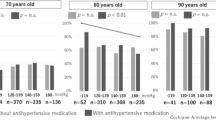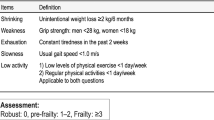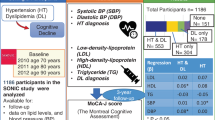Abstract
Although several studies have reported on the relation between high blood pressure (BP) and impaired activities of daily living (ADL), only a few studies have reported on the relation of high BP in middle-aged subjects with future impaired ADL. Furthermore, no studies reported an excess impaired ADL due to non-normal BP. Using ADL 1999 data, we compared data from NIPPON DATA80 survivors without impaired ADL (N=1816) with those with impaired ADL (N=75) using baseline BP information collected in 1980. We analysed participants who were aged 47–59 years at baseline. Multiple adjusted logistic regression analyses were used to estimate the risk of impaired ADL, according to baseline BP categories using Joint National Committee 7 guidelines (normal BP, prehypertension, stage 1 hypertension (HT) and stage 2 HT). Subjects who used antihypertensive medications were classified as having stage 2 HT. We calculated excess impaired ADL due to non-normal BP. Compared with normal BP categories, the adjusted odds ratio (OR) and 95% confidence interval (CI) of having impaired ADL was higher in subjects with prehypertension (OR=1.50, 95% CI: 0.55–4.09), stage 1 HT (OR=1.56, 95% CI: 0.56–4.32) and stage 2 HT (OR=2.96, 95% CI: 1.09–8.05). Non-normal BP explained 45% (33.7/75) of impaired ADL. A positive relation of BP categories with the composite end point of mortality and impaired ADL was also observed. In conclusion, controlling BP in middle age may prevent deaths and future ADL decline.
This is a preview of subscription content, access via your institution
Access options
Subscribe to this journal
Receive 12 digital issues and online access to articles
$119.00 per year
only $9.92 per issue
Buy this article
- Purchase on Springer Link
- Instant access to full article PDF
Prices may be subject to local taxes which are calculated during checkout

Similar content being viewed by others
References
Chobanian AV, Bakris GL, Black HR, Cushman WC, Green LA, Izzo Jr JL et al., National Heart, Lung, and Blood Institute Joint National Committee on Prevention, Detection, Evaluation, and Treatment of High Blood Pressure; National High Blood Pressure Education Program Coordinating Committee. The Seventh Report of the Joint National Committee on Prevention, Detection, Evaluation, and Treatment of High Blood Pressure: the JNC 7 report. JAMA 2003; 289: 2560–2572.
Mancia G, De Backer G, Dominiczak A, Cifkova R, Fagard R, Germano G, et al., Management of Arterial Hypertension of the European Society of Hypertension; European Society of Cardiology. 2007 Guidelines for the Management of Arterial Hypertension: The Task Force for the Management of Arterial Hypertension of the European Society of Hypertension (ESH) and of the European Society of Cardiology (ESC). J Hypertens 2007; 25: 1105–1187.
Japanese Society of Hypertension. Japanese Society of Hypertension guidelines for the management of hypertension (JSH 2004). Hypertens Res 2006; 29 (Suppl): S1–S105.
Hayakawa T, Okayama A, Ueshima H, Kita Y, Choudhury SR, Tamaki J, on the behalf of the NIPPON DATA80 Research Group. Prevalence of impaired activity of daily living and the impact of stroke and lower limb fracture in elderly persons in Japan. CVD prevention 2000; 3: 187–194.
Ohmori K, Kuriyama S, Hozawa A, Ohkubo T, Tsubono Y, Tsuji I . Modifiable factors for the length of life with disability before death: mortality retrospective study in Japan. Gerontology 2005; 51: 186–191.
Wang L, van Belle G, Kukull WB, Larson EB . Predictors of functional change: a longitudinal study of nondemented people aged 65 and older. J Am Geriatr Soc 2002; 50: 1525–1534.
Kuo HK, Jones RN, Milberg WP, Tennstedt S, Talbot L, Morris JN et al. Effect of blood pressure and diabetes mellitus on cognitive and physical functions in older adults: a longitudinal analysis of the advanced cognitive training for independent and vital elderly cohort. J Am Geriatr Soc 2005; 53: 1154–1161.
Nishinaga M, Takata J, Okumiya K, Matsubayashi K, Ozawa T, Doi Y et al. High morning home blood pressure is associated with a loss of functional independence in the community-dwelling elderly aged 75 years or older. Hypertens Res 2005; 28: 657–663.
Roos NP, Havens B . Predictors of successful aging: a twelve-year study of Manitoba elderly. Am J Public Health 1991; 81: 63–68.
Pinsky JL, Branch LG, Jette AM, Haynes SG, Feinleib M, Cornoni-Huntley JC et al. Framingham Disability Study: relationship of disability to cardiovascular risk factors among persons free of diagnosed cardiovascular disease. Am J Epidemiol 1985; 122: 644–656.
Reed DM, Foley DJ, White LR, Heimovitz H, Burchfiel CM, Masaki K . Predictors of healthy aging in men with high life expectancies. Am J Public Health 1998; 88: 1463–1468.
Guralnik JM, Kaplan GA . Predictors of healthy aging: prospective evidence from the Alameda County study. Am J Public Health 1989; 79: 703–708.
Okamura T, Hayakawa T, Kadowaki T, Kita Y, Okayama A, Elliott P et al., NIPPON DATA80 research group. A combination of serum low albumin and above-average cholesterol level was associated with excess mortality. J Clin Epidemiol 2004; 57: 1188–1195.
Ueshima H, Choudhury SR, Okayama A, Hayakawa T, Kita Y, Kadowaki T et al. Cigarette smoking as a risk factor for stroke death in Japan: NIPPON DATA80. Stroke 2004; 35: 1836–1841.
Okamura T, Hayakawa T, Kadowaki T, Kita Y, Okayama A, Elliott P et al., NIPPONDATA80 Research Group. Resting heart rate and cause-specific death in a 16.5-year cohort study of the Japanese general population. Am Heart J 2004; 147: 1024–1032.
Okamura T, Tanaka H, Miyamatsu N, Hayakawa T, Kadowaki T, Kita Y et al., NIPPON DATA80 research group. The relationship between serum total cholesterol and all-cause or cause-specific mortality in a 17.3-year study of a Japanese cohort. Atherosclerosis 2007; 190: 216–223.
Okamura T, Hayakawa T, Hozawa A, Kadowaki T, Murakami Y, Kita Y et al., NIPPON DATA80 research group. Lower levels of serum albumin and total cholesterol were associated with decline in activities of daily living and excess mortality in a 12-year cohort study of elderly Japanese. J Am Geriatr Soc 2008; 56: 529–535.
Kadowaki S, Okamura T, Hozawa A, Kadowaki T, Kadota A, Murakami Y et al., NIPPON DATA Research Group. Relationship of elevated casual blood glucose level with coronary heart disease, cardiovascular disease and all-cause mortality in a representative sample of the Japanese population. NIPPON DATA80. 2008; 51: 575–582.
Okamura T, Hayakawa T, Kadowaki T, Kita Y, Okayama A, Ueshima H, NIPPON DATA90 Research Group. The inverse relationship between serum high-density lipoprotein cholesterol level and all-cause mortality in a 9.6-year follow-up study in the Japanese general population. Atherosclerosis 2006; 184: 143–150.
Hozawa A, Okamura T, Kadowaki T, Murakami Y, Nakamura K, Hayakawa T, et al., NIPPON DATA90 Research Group. Gamma-Glutamyltransferase predicts cardiovascular death among Japanese women. Atherosclerosis 2007; 194: 498–504.
Kadota A, Hozawa A, Okamura T, Kadowak T, Nakmaura K, Murakami Y et al., NIPPON DATA Research Group. Relationship between metabolic risk factor clustering and cardiovascular mortality stratified by high blood glucose and obesity: NIPPON DATA90, 1990–2000. Diabetes Care 2007; 30: 1533–1538.
Katz S, Downs TD, Cash HR, Grotz RC . Progress in development of the index of ADL. Gerontologist 1970; 10: 20–30.
Rockhill B, Newman B, Weinberg C . Use and misuse of population attributable fractions. Am J Public Health 1998; 88: 15–19.
World Health Organization. World Health Report 2004: Changing History (World Health Report). World Health Organization: Geneva, 2002.
Statistics and Information Department, Minister's Secretariat, Ministry of Health, Labour and Welfare. The 20th Life Tables. Health and Welfare Statistics Association: Tokyo, 2007 (in Japanese).
Acknowledgements
We thank all members of the Japanese Association of Public Health Center Directors and all staff of the public health centres that cooperated with our study. This study was supported by a Grant-in-Aid from the Ministry of Health and Welfare under the auspices of the Japanese Association for Cerebro-cardiovascular Disease Control, a Research Grant for Cardiovascular Diseases (7A-2) from the Ministry of Health, Labour and Welfare and a Health and Labour Sciences Research Grant, Japan (Comprehensive Research on Aging and Health: H11-chouju-046, H14-chouju-003, H17-chouju-012 and H19-chouju-014).
Author information
Authors and Affiliations
Consortia
Corresponding author
Additional information
Conflict of interest
There are no conflicts of interest.
Appendix
Appendix
List of the NIPPON DATA80 Research Group.
NIPPON DATA: ‘National Integrated Project for Prospective Observation of Non-communicable Disease And its Trends in the Aged.’
Chairman: Hirotsugu Ueshima (Department of Health Science, Shiga University of Medical Science, Otsu, Shiga).
Consultant: Osamu Iimura (Hokkaido JR Sapporo Hospital, Sapporo, Hokkaido), Teruo Omae (Health C&C Center, Hisayama, Kasuya, Fukuoka), Kazuo Ueda (Murakami Memorial Hospital, Nakatsu, Oita), Hiroshi Yanagawa (Saitama Prefectural University, Koshigaya, Saitama), Hiroshi Horibe (Aichi Medical University, Nagakute, Aichi).
Participating researchers: Akira Okayama (The First Institute of Health Service, Japan Anti-Tuberculosis Association, Chyioda-ku, Tokyo), Kazunori Kodama, Fumiyoshi Kasagi (Department of Epidemiology, Radiation Effects Research Foundation, Hiroshima, Hiroshima), Tomonori Okamura (Department of Preventive Cardiology, National Cardiovascular Center, Suita, Osaka), Yoshikuni Kita (Department of Health Science, Shiga University of Medical Science, Otsu, Shiga), Takehito Hayakawa (Department of Hygiene and Preventive Medicine, Fukushima Medical University, Fukushima, Fukushima), Shinichi Tanihara (Department of Hygiene and Preventive Medicine, Fukuoka University School of Medicine, Fukuoka, Fukuoka), Shigeyuki Saito (Second Department of Internal Medicine, Sapporo Medical University School of Medicine, Sapporo, Hokkaido), Kiyomi Sakata (Department of Hygiene and Preventive Medicine, Iwate Medical University School of Medicine, Morioka, Iwate), Yosikazu Nakamura (Department of Public Health, Jichi Medical University School of Medicine, Shimotsuke, Tochigi), Fumihiko Kakuno (Higashiomi Public Health Center, Higashiomi, Shiga).
Participating research associates: Toshihiro Takeuchi, Mitsuru Hasebe, Fumitsugu Kusano, Takahisa Kawamoto and members of 300 Public Health Centers in Japan, Masumi Minowa (Faculty of Humanities, Seitoku University, Matsudo, Chiba), Minoru Iida (Kansai University of Welfare Sciences, Kashiwara, Osaka), Tsutomu Hashimoto (Kinugasa General Hospital, Yokosuka, Kanagawa), Shigemichi Tanaka (Department of Cardiology, Cardiovascular Center, Teine Keijinkai, Sapporo, Hokkaido), Atsushi Terao (Health Promotion Division, Department of Public Health and Welfare, Shiga Prefecture, Otsu, Shiga), Katsuhiko Kawaminami (Department of Public Health Policy, National Institute of Public Health, Wako, Saitama), Koryo Sawai (The Japanese Association for Cerebro-cardiovascular Disease Control, Tokyo), Shigeo Shibata (Clinical Nutrition, Kagawa Nutrition University, Sakado, Saitama).
Rights and permissions
About this article
Cite this article
Hozawa, A., Okamura, T., Murakami, Y. et al. High blood pressure in middle age is associated with a future decline in activities of daily living. NIPPON DATA80. J Hum Hypertens 23, 546–552 (2009). https://doi.org/10.1038/jhh.2008.155
Received:
Revised:
Accepted:
Published:
Issue Date:
DOI: https://doi.org/10.1038/jhh.2008.155
Keywords
This article is cited by
-
Hypertension, the decline of activities of daily living (ADL) and frailty
Hypertension Research (2022)
-
Functional status and its associated factors among community-dwelling older adults in rural Nepal: findings from a cross-sectional study
BMC Geriatrics (2021)
-
Stair climbing activity and vascular function in patients with hypertension
Hypertension Research (2021)
-
Hypertensive disorders of pregnancy, obesity, and hypertension in later life by age group: a cross-sectional analysis
Hypertension Research (2020)
-
Factors associated with intra-individual visit-to-visit variability of blood pressure in four countries: the INTERMAP study
Journal of Human Hypertension (2019)



